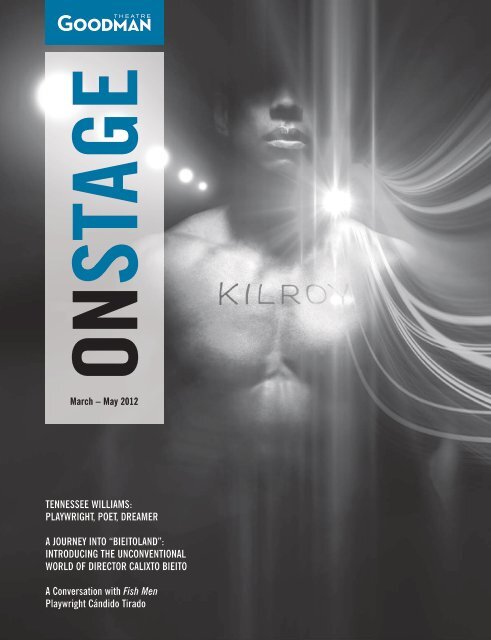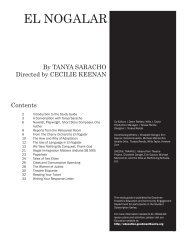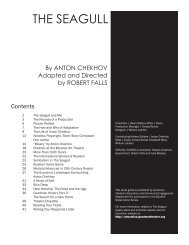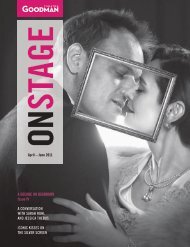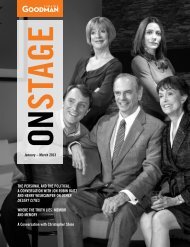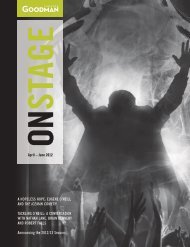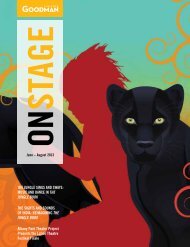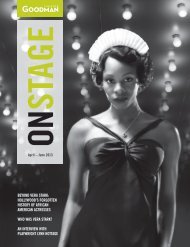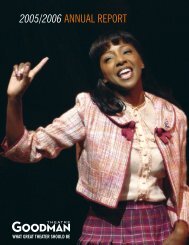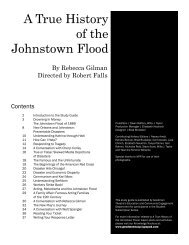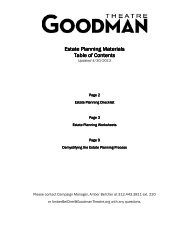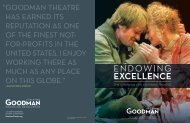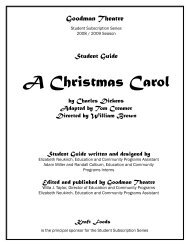Download - Goodman Theatre
Download - Goodman Theatre
Download - Goodman Theatre
You also want an ePaper? Increase the reach of your titles
YUMPU automatically turns print PDFs into web optimized ePapers that Google loves.
March – May 2012<br />
TENNESSEE WILLIAMS:<br />
PLAYWRIGHT, POET, DREAMER<br />
A JOURNEY INTO “BIEITOLAND”:<br />
INTRODUCING THE UNCONVENTIONAL<br />
WORLD OF DIRECTOR CALIXTO BIEITO<br />
A Conversation with Fish Men<br />
Playwright Cándido Tirado
March – May 2012<br />
CONTENTS<br />
In the Albert<br />
1 Why Camino Real?<br />
2 Tennessee Williams: Playwright, Poet, Dreamer<br />
7 Tennessee in Chicago<br />
8 A Journey into “Bieitoland”: Introducing the Unconventional World<br />
of Director Calixto Bieito<br />
In the Owen<br />
12 A Conversation with Cándido Tirado<br />
15 For Love or Money: The World of Chess Hustling<br />
At the <strong>Goodman</strong><br />
16 Insider Access Series<br />
In the Wings<br />
17 Imparting Culture and Communication: A Conversation with Ira Abrams<br />
Scene at the <strong>Goodman</strong><br />
19 Race Opening Night<br />
Celebrating Race and Diversity<br />
Off Stage<br />
20 A Legacy of Great Theater<br />
For Subscribers<br />
21 Calendar<br />
VOLUME 27 #3<br />
Co-Editors | Lesley Gibson, Lori Kleinerman,<br />
Tanya Palmer<br />
Graphic Designer | Tyler Engman<br />
Production Manager | Lesley Gibson<br />
Contributing Writers/Editors | Neena<br />
Arndt, Jeff Ciaramita, Jeffrey Fauver, Lisa<br />
Feingold, Katie Frient, Lesley Gibson, Lori<br />
Kleinerman, Caitlin Kunkel, Dorlisa Martin,<br />
Julie Massey, Tanya Palmer, Teresa Rende,<br />
Victoria Rodriguez, Denise Schneider, Steve<br />
Scott, Jenny Seidelman, Willa J. Taylor,<br />
Kate Welham.<br />
OnStage is published in conjunction with<br />
<strong>Goodman</strong> <strong>Theatre</strong> productions. It is<br />
designed to serve as an information source<br />
for <strong>Goodman</strong> <strong>Theatre</strong> Subscribers. For ticket<br />
and subscription information call<br />
312.443.3810. Cover: Image design and<br />
direction by Kelly Rickert.<br />
<strong>Goodman</strong> productions are made possible<br />
in part by the National Endowment for the<br />
Arts; the Illinois Arts Council, a state agency;<br />
and a CityArts grant from the City of<br />
Chicago Department of Cultural Affairs and<br />
Special Events; and the Leading National<br />
<strong>Theatre</strong>s Program, a joint initiative of the<br />
Doris Duke Charitable Foundation and the<br />
Andrew W. Mellon Foundation.<br />
Written comments and<br />
inquiries should be sent to:<br />
The Editor, OnStage<br />
<strong>Goodman</strong> <strong>Theatre</strong><br />
170 North Dearborn Street<br />
Chicago, IL 60601<br />
or email us at:<br />
OnStage@<strong>Goodman</strong><strong>Theatre</strong>.org
IN THE ALBERT<br />
FROM THE ARTISTIC DIRECTOR<br />
Photo by Brian Kuhlmann.<br />
Why Camino Real?<br />
During my tenure as artistic director I have had the privilege of bringing some of the most notable directors now working<br />
on the world stage to the <strong>Goodman</strong>, including Peter Sellars, JoAnne Akalaitis, Ivo van Hove, Elizabeth LeCompte,<br />
Flora Lauten (from the esteemed Cuban company Teatro Buendía) and our own Mary Zimmerman. Although vastly<br />
different in style and approach, these directors share a passion for exploring new ways of theatrical storytelling, an<br />
uncompromising singularity of vision and a radical (and often controversial) way of reimagining classical texts. To this<br />
group I am extremely proud to add Calixto Bieito, a Barcelona-based director whose soaring, radical interpretations<br />
of everything from classic operas to Shakespeare have astonished, inflamed and challenged audiences throughout<br />
Europe and South America.<br />
My first experience with Calixto’s work came in 2004, with his sexually charged interpretation of Mozart’s The<br />
Abduction from the Seraglio in Berlin. I found that production to be both fascinating and disturbing; Calixto’s investigation<br />
of the dark subtext that lay beneath the “classical” exterior of the piece displayed a courage and sophistication<br />
that was, to me, profound and unsettling. Soon after the performance I met with him, and was immediately<br />
impressed by his warmth, intelligence and infectious passion for his work. When we began to discuss possible<br />
projects that might be of interest to him, he revealed his love for the works of one of my favorite writers, Tennessee<br />
Williams. Though our conversation began with a discussion of Williams’ better-known works, in talking to Calixto<br />
it occurred to me that his bold artistry might be better used to explore one of Williams’ less often performed plays,<br />
Camino Real. First produced in 1953, Camino remains one of the author’s most poetic works, and one of his most<br />
ambitious: it is an impressionistic musing on the nature of love, loss, humanity and the encroachment of time,<br />
peopled largely by iconic figures of romance who are coming to terms with their own mortality. Because of its nonrealistic<br />
milieu and aching lyricism, I felt that this seldom-produced work, long considered one of Williams’ most<br />
personal, would inspire Calixto to do what he does best: to create a world in which the playwright’s images and ideas<br />
could take flight and soar. After reading the play, Calixto agreed, and the result is a full-bodied, extraordinarily theatrical<br />
piece which fuses Williams’ poetry, music and evocative imagery to create, in Williams’ words, “the continually<br />
dissolving and transforming images of a dream.”<br />
Although Camino Real is notably based less in realism than its author’s more familiar works, it shares with those<br />
plays a highly charged blend of disparate elements: beauty and brutality; moments of romance punctuated by shocking<br />
dissolution. As interpreted by one of today’s most courageous and uncompromising directors, I guarantee that its<br />
vivid images and haunting, sometimes squalid beauty will live with you for a long, long time.<br />
Robert Falls<br />
Artistic Director<br />
1
IN THE ALBERT<br />
2
Tennessee Williams:<br />
Playwright, Poet, Dreamer<br />
By Neena Arndt<br />
Tennessee Williams,<br />
circa 1955. Photo by<br />
FPG/Archive Photos/<br />
Getty Images.<br />
In the foreword to his phantasmagoric<br />
1953 allegory, Camino Real, playwright<br />
Tennessee Williams, who by then had<br />
made a name for himself with psychological<br />
dramas like A Streetcar Named Desire<br />
and The Glass Menagerie, wrote, “More<br />
than any other work I have done, this<br />
play has seemed to me like a construction<br />
of another world, a separate existence.”<br />
Casual Williams fans may remain<br />
unfamiliar with the dreamlike Camino<br />
Real, which differs stylistically from his<br />
better-known works. In fact, those who<br />
know only Williams’ “greatest hits” might<br />
be hard-pressed to believe that Camino<br />
Real—broad in scope and sweepingly<br />
ambitious—flowed from the same pen<br />
as the classics they cherish. But Camino<br />
Real springs from the deepest recesses of<br />
Williams’ heart and psyche, and offers a<br />
glimpse into the staggering imagination of<br />
this multifaceted writer.<br />
In 1951, two years before Camino Real<br />
premiered, Tennessee Williams became<br />
a household name when 27-year-old<br />
Marlon Brando swaggered and shouted<br />
his way to immortality as Stanley<br />
Kowalski in the film A Streetcar Named<br />
Desire. Under the direction of Elia<br />
Kazan, Brando portrayed Williams’ most<br />
iconic male character as lustful and sensuous,<br />
giving a grandiose performance<br />
that nonetheless was grounded in the<br />
realistic acting style of which Brando<br />
was a master. An early “method” actor,<br />
Brando was steeped in the theories of<br />
visionary Russian director Konstantin<br />
Stanislavsky, which permeated American<br />
theater and film in the mid-twentieth<br />
century. This style supplanted melodrama,<br />
which saw its heyday in the nineteenth<br />
century and took its last fluttery<br />
breaths in the middle of the twentieth,<br />
when writers like Tennessee Williams,<br />
Eugene O’Neill and Arthur Miller transformed<br />
the American stage with such<br />
masterworks as Streetcar, Long Day’s<br />
Journey into Night and Death of a<br />
Salesman. Directly imitating real life had<br />
never been among melodrama’s goals,<br />
but now, both on stage and on screen,<br />
many artists aimed to hold up a mirror<br />
to the world around them.<br />
Today, Tennessee Williams is most often<br />
remembered as one of the writers who<br />
pioneered this style in America. Indeed,<br />
the works for which he is best known use<br />
largely realistic plots and characters to<br />
achieve Williams’ goal of rooting around<br />
the human psyche. Their stories concern<br />
SYNOPSIS<br />
Tennessee Williams’ hauntingly poetic<br />
allegory takes us to a surreal, deadend<br />
town occupied by a colorful collection<br />
of lost souls anxious to escape<br />
but terrified of the unknown wasteland<br />
lurking beyond the city’s walls. When<br />
Kilroy, an American traveler and former<br />
boxer, inadvertently lands in this<br />
netherworld, he sets off on a fantastical<br />
adventure through illusion and<br />
temptation in an attempt to flee its<br />
confines—and defy his grim destiny.<br />
3
IN THE ALBERT<br />
“More than any other work I have<br />
done, this play has seemed to me like<br />
a construction of another world,<br />
a separate existence.”<br />
—Tennessee Williams<br />
events that could occur in the real world,<br />
and their characters confront their problems<br />
in psychologically realistic ways. Yet,<br />
even in these works, Williams’ language<br />
is languidly poetic, and his stage directions<br />
often indicate that he envisioned his<br />
works being performed with an undercurrent<br />
of visual and auditory metaphors. In<br />
A Streetcar Named Desire, for example,<br />
Williams indicates that Blanche’s descent<br />
into madness is underscored by echoing<br />
voices and “jungle noises.” If, in the text<br />
of Streetcar, Williams is holding a mirror<br />
up to life, it is a warped mirror, each distortion<br />
meticulously sculpted. The poetic<br />
elements in these works afford readers a<br />
glimpse of his wide-ranging sensibilities.<br />
But in order to fully appreciate the vastness<br />
of Williams’ dramatic imagination,<br />
one has to experience his more overtly<br />
surrealistic works like Camino Real, The<br />
Gnädiges Fräulein or Stairs to the Roof .<br />
In The Gnädiges Fräulein, a pair of southern<br />
ladies chatter and preen in rocking<br />
chairs while being entertained by a retired<br />
vaudeville performer who has had her<br />
eyes pecked out by an oversized bird. In<br />
Stairs to the Roof, the characters go on a<br />
whirlwind surreal journey before ascending<br />
symbolic stairs to the roof of an office.<br />
Here, the mirror Williams uses is straight<br />
out of a fun house—and like those twisted<br />
images that confront us at carnivals,<br />
they provide a different, but equally valid,<br />
way of perceiving and making sense of<br />
the world.<br />
The phrase “camino real” translates from<br />
Spanish as “royal road,” but in Williams’<br />
play it ironically represents a dead end.<br />
Camino Real places familiar characters<br />
from literature—such as Don Quixote,<br />
Casanova and Lord Byron—in a mythical<br />
town in an unspecified Latin American<br />
country where the “spring of humanity<br />
has gone dry.” Although the play contains<br />
references that place it in the twentieth<br />
century—an airplane, for example—the<br />
play’s time period remains fluid and<br />
ambiguous. The presence of literary<br />
characters from different eras reinforces<br />
the notion that the action occurs either in<br />
many time periods simultaneously, or in<br />
no time period in particular. These literary<br />
characters are joined by characters<br />
who are products of Williams’ imagination,<br />
such as an enigmatic gypsy and a<br />
freaky faction of “streetcleaners” whose<br />
job is to remove corpses from the streets.<br />
Much of the action centers around Kilroy,<br />
a newly arrived American whose name is<br />
inspired by the popular World War II era<br />
graffiti phrase “Kilroy was here.” A prizefighter<br />
with a “heart as big as a baby’s<br />
head,” Kilroy first appears to be the all-<br />
American hero—but the nightmare dreamscape<br />
in which he now finds himself<br />
proves more treacherous than any fighting<br />
ring. While Kilroy and his fellow inhabitants<br />
of the town are theoretically free to<br />
leave, outgoing transportation is sporadic<br />
and a vast desert wasteland stretches to<br />
the horizon—so setting out on foot seems<br />
foolhardy. Most of the characters remain<br />
stuck in their current situations, both<br />
geographically and emotionally, allowing<br />
Williams to explore the inner workings of<br />
their desperation, and their love for (or<br />
perhaps just attachment to) each other.<br />
4
OPPOSITE: Vivien Leigh and Marlon Brando in A<br />
Streetcar Named Desire. ©Bettman/CORBIS. BOTTOM:<br />
Denholm Elliot and Elizabeth Seal in a scene from<br />
the Tennessee Williams’ play Camino Real. Photo by<br />
Popperfoto/Getty Images.<br />
Just as they occupy the town, the characters<br />
also inhabit the fertile landscape<br />
of Tennessee Williams’ mind, representing<br />
his experience of the world rather<br />
than the world’s literal outward appearance.<br />
Prior to Camino Real’s Broadway<br />
opening in 1953, Williams published an<br />
essay in The New York Times describing<br />
his thought processes about the play:<br />
My desire was to give audiences my<br />
own sense of something wild and<br />
unrestricted that ran like water in the<br />
mountains, or clouds changing shape<br />
in a gale, or the continually dissolving<br />
and transforming images of a dream.<br />
This sort of freedom is not chaos nor<br />
anarchy. On the contrary, it is the result<br />
of painstaking design, and in this work<br />
I have given more conscious attention<br />
to form and construction than I have<br />
in any work before. Freedom is not<br />
achieved simply by working freely.<br />
in 1953, theatergoers scratched their<br />
heads over Samuel Beckett’s Waiting for<br />
Godot, another play which places little<br />
focus on plot—but is now considered<br />
a staple of the Western canon.) Critic<br />
William Hawkins noted, “The first thing<br />
evident about this brave new play of<br />
Tennessee Williams is that explanations<br />
of it that suit you may not suit anybody<br />
else. The playwright has composed his<br />
work in terms of pure emotions. They<br />
are abstract, without excuse or motivation.<br />
What you see and hear is the effect<br />
on the heart, of human nature when it<br />
is greedy or hilarious or sorry for itself.”<br />
For other critics, the play inspired less<br />
openmindedness: John McClain opined,<br />
“There is not the slightest doubt that Mr.<br />
Williams has some provocative and highflown<br />
thoughts about love and life, and<br />
he is capable of lyrical and humorous<br />
and sometimes utterly earthy writing, but<br />
it seems to me that in this instance he<br />
knocked himself out being oblique.”<br />
Never inclined to scorn or ignore his<br />
audiences’ reactions to his plays,<br />
Williams returned to the typewriter<br />
after the play opened on Broadway and<br />
revised the script. The published version<br />
reflects the changes he made to help<br />
audiences enter his admittedly mysterious<br />
world—an added prologue which<br />
sets up the action, and some additional<br />
When the play premiered on Broadway<br />
in a lavish production by Elia Kazan,<br />
some critics and audiences applauded its<br />
stylistic originality, while others decried<br />
its lack of storyline and expressed confusion<br />
regarding Williams’ intentions. (Also<br />
WOMEN’S BOARD<br />
SPONSORS CAMINO REAL<br />
The <strong>Goodman</strong> <strong>Theatre</strong> Women’s Board continues<br />
a long tradition of support for exciting and challenging<br />
work with its sponsorship of Camino<br />
Real. Since its formation in 1978, the Women’s<br />
Board has made it part of its mission to sponsor<br />
a production every season and provide<br />
crucial funding for the <strong>Goodman</strong>’s Education and<br />
Community Engagement programs.<br />
<strong>Goodman</strong> <strong>Theatre</strong> gratefully salutes the Women’s<br />
Board as a Major Production Sponsor of Camino<br />
Real, and is extremely thankful for the dedication<br />
and generosity of its members.<br />
5
IN THE ALBERT<br />
scenes. Williams was also careful to<br />
note, in an afterword, that due to its reliance<br />
on visual elements, this particular<br />
play would provide a far more satisfying<br />
experience on the stage than on<br />
the page. While he acknowledged that<br />
some plays are “meant for reading,” he<br />
emphasized that text is not always of<br />
primary importance to a play:<br />
Of all the works I have written, this<br />
one was meant most for the vulgarity<br />
of performance. The printed script of a<br />
play is hardly more than an architect’s<br />
blueprint of a house not yet built or<br />
built and destroyed. The color, the<br />
grace and levitation, the structural<br />
pattern in motion, the quick interplay<br />
of live beings, suspended like fitful<br />
lightning in a cloud, these things are<br />
the play, not words on paper, nor<br />
thoughts and ideas of an author, those<br />
shabby things snatched off basement<br />
counters at Gimbel’s.<br />
In the years following, the revised play<br />
went on to numerous regional productions<br />
(including one at the <strong>Goodman</strong> in<br />
1958), usually receiving mixed reviews.<br />
In 1970 it was revived in New York by<br />
the Lincoln Center Repertory Company,<br />
and critic Clive Barnes proclaimed,<br />
“There are people who think that Camino<br />
Real is Tennessee Williams’ best play,<br />
and I believe that they are right. It is a<br />
play torn out of a human soul.” Barnes<br />
went on to observe that when the play<br />
was first produced in 1953, “there were<br />
many who found it obscure. Our standards<br />
of obscurity, like our standards of<br />
obscenity, have escalated since those<br />
dark days of theatrical innocence.” When<br />
Barnes wrote those words, only 17<br />
years had passed since Camino Real’s<br />
premiere—now, we experience Williams’<br />
work at a distance of nearly 60 years. In<br />
the interim, innovative playwrights like<br />
Samuel Beckett, Harold Pinter, Eugene<br />
Ionesco and countless others have<br />
“The playwright has composed his work<br />
in terms of pure emotions. They are<br />
abstract, without excuse or motivation.<br />
What you see and hear is the effect on<br />
the heart, of human nature when it is<br />
greedy or hilarious or sorry for itself.”<br />
—William Hawkins, Critic<br />
spurred audiences to expand their ideas<br />
of what constitutes a play. These writers<br />
employ techniques such as extensive<br />
use of symbolism and placing their plays<br />
in no particular place or time. Viewed<br />
through the lens of history, Camino Real<br />
seems less radical than it did in 1953—<br />
though it remains a vivid, visceral peek<br />
into the mind of one of America’s most<br />
complex and beloved playwrights.<br />
BOTTOM: Mundy Spears and Emily Webbe in The Gnädiges<br />
Fräulein performed as part of WSC Avant Bard’s 2011<br />
Tennessee Continuum. Photo C. Stanley Photography.<br />
HONORING A LEGACY:<br />
HOPE ABELSON AND<br />
CAMINO REAL<br />
Through its 2011/2012 production of Camino<br />
Real, <strong>Goodman</strong> <strong>Theatre</strong> honors the legacy of a<br />
true luminary of the Chicago arts world, the late<br />
Hope Abelson. At the <strong>Goodman</strong>—as well as<br />
many if not all theaters in Chicago—Hope was<br />
a champion of new work.<br />
Hope began her life in the arts as a performer,<br />
working as an actress in radio drama. Her<br />
career led her to serve as a producer for several<br />
Broadway shows. She also founded the American<br />
Friends of the Stratford Shakespeare Festival and<br />
she was instrumental in the early days of the<br />
League of Chicago <strong>Theatre</strong>s.<br />
In 1953, Hope served as an assistant on the<br />
original production of Camino Real. She was<br />
responsible for daily script changes and she made<br />
herself indispensable to both Tennessee Williams<br />
and the play’s director, Elia Kazan. She became a<br />
critical supporter of arts organizations large and<br />
small, including the Chicago Symphony Orchestra,<br />
Ravinia Festival, Court <strong>Theatre</strong>, Victory Gardens<br />
Theater and Steppenwolf <strong>Theatre</strong> Company. Hope<br />
was an early board member of the <strong>Goodman</strong> and<br />
also served on the Illinois Arts Council.<br />
The <strong>Goodman</strong> is grateful to her daughter Katherine<br />
Abelson, a <strong>Goodman</strong> Women’s Board member,<br />
and Katherine’s husband Robert J. Cornell, for<br />
carrying on this tradition through their support<br />
of our education and community engagement<br />
programs for Camino Real.<br />
Hope Abelson and her daughter Katherine at the <strong>Goodman</strong>’s Inaugural Gala.<br />
6
LEFT: Peg Murray and<br />
Scott Jaeck in <strong>Goodman</strong><br />
<strong>Theatre</strong>’s 1982 production<br />
of Tennessee<br />
Williams’ A House Not<br />
Meant to Stand. Photo<br />
by Lisa Ebright. BELOW:<br />
Tennessee Williams<br />
and <strong>Goodman</strong> <strong>Theatre</strong><br />
Executive Director Roche<br />
Schulfer outside the<br />
<strong>Goodman</strong> Studio.<br />
Tennessee and Chicago<br />
By Steve Scott<br />
Although the city most often associated<br />
with Tennessee Williams’ work was New<br />
Orleans (his adopted home and the setting<br />
of some of his most famous works), it was<br />
Chicago that gave him his first real success<br />
in the theater and that would provide<br />
artistic haven to him late in his career.<br />
Williams’ love affair with the Windy City<br />
began in 1944 with the landmark success<br />
of The Glass Menagerie, produced<br />
at the Civic <strong>Theatre</strong> prior to its arrival on<br />
Broadway. Claudia Cassidy, the venerated<br />
critic for the Chicago Tribune, became a<br />
passionate advocate for the play, writing<br />
in her initial review that, “it reaches out<br />
its tentacles, first tentative, then gripping,<br />
and you are caught in its spell.” Cassidy’s<br />
praise, and her continued exhortations<br />
to local audiences to support the play,<br />
brought national attention to the work<br />
before it had even moved to New York,<br />
and helped establish Williams as the preeminent<br />
dramatist of his generation.<br />
Thereafter, Williams considered Chicago<br />
to be one of the best theater towns in<br />
the world; in a 1951 letter to Cassidy,<br />
he urged her to stump for the establishment<br />
of a strong locally based theater<br />
community here, exclaiming, “No better<br />
place on Earth!” Touring productions<br />
of his Broadway hits were a staple in<br />
Chicago in the 1950s and 1960s, and,<br />
as local producing companies began to<br />
sprout, Williams’ plays were an important<br />
part of their repertoire. Director<br />
George Keathley’s first major hit at the<br />
old Ivanhoe <strong>Theatre</strong> was a much-lauded<br />
revival of The Rose Tattoo which swept<br />
the first annual Joseph Jefferson Awards<br />
in 1969. Two years later, Keathley produced<br />
the world premiere of Williams’<br />
Out Cry, an experience unfortunately<br />
marred by the playwright’s erratic behavior—although<br />
Williams later admitted,<br />
after the failure of a subsequent New<br />
York production with a different director,<br />
that the play “was better in Chicago.”<br />
Problems also plagued the 1980 premiere<br />
of Clothes for a Summer Hotel, which<br />
starred <strong>Goodman</strong> School of Drama alumna<br />
Geraldine Page as the ill-fated Zelda<br />
Fitzgerald; although Williams himself was<br />
in better emotional shape, his play was<br />
greeted with critical disappointment.<br />
Later that year, the playwright embarked<br />
on an alliance with <strong>Goodman</strong> <strong>Theatre</strong><br />
that would result in in his final major<br />
work for the stage. Some Problems for<br />
the Moose Lodge, which was produced<br />
first in the <strong>Goodman</strong> Studio as one of<br />
three short plays collectively billed as<br />
Tennessee Laughs<br />
(a title Williams<br />
apparently loathed),<br />
was a darkly savage<br />
comedy detailing<br />
the travails of<br />
Cornelius and Bella<br />
McCorkle, an elderly<br />
couple dealing with<br />
the disintegration<br />
of their family and<br />
their marriage. The<br />
reception of Moose<br />
Lodge was positive<br />
enough to encourage<br />
Williams to expand the play into a longer<br />
one-act, now entitled A House Not Meant<br />
to Stand, produced in 1981, again in the<br />
<strong>Goodman</strong> Studio. Despite some critical<br />
misgivings, Williams kept working on the<br />
play, encouraged by then-Artistic Director<br />
Gregory Mosher; the result was a fulllength<br />
version of House, which premiered<br />
on the <strong>Goodman</strong> mainstage in the spring<br />
of 1982. Now subtitled by the author<br />
“A Gothic Comedy,” the new version<br />
expanded the expressionistic absurdities<br />
of its earlier drafts, revealing even more<br />
passionately the playwright’s own frustrations<br />
with the challenges of aging; as<br />
Richard Christiansen noted in his Chicago<br />
Tribune review, “it is a loud, harsh, bitter<br />
pain-filled shriek at the degenerative process<br />
of life…a tantalizing and frustrating<br />
creation.” A House Not Meant to Stand<br />
would be the last production with which<br />
Williams himself would be associated;<br />
tragically, he died nine months later.<br />
7
IN THE ALBERT<br />
A Journey into “Bieitoland”:<br />
Introducing the Unconventional<br />
World of Director Calixto Bieito<br />
By Tanya Palmer<br />
Fluent in five languages, Bieito has juggled<br />
a career in his native Spain—where<br />
he was the artistic director of Barcelona’s<br />
Teatre Romea from 1999 to 2011—with<br />
an international career directing primarily<br />
opera around the globe. His work<br />
has taken him to Germany, Belgium, the<br />
United Kingdom, Scandinavia, France,<br />
Italy, Switzerland, South America and<br />
Mexico, but his upcoming collaboration<br />
with the <strong>Goodman</strong> will mark only the second<br />
time his work will have been seen in<br />
the United States, and his first collaboration<br />
with American actors and designers<br />
on the work of an American playwright.<br />
Over the past 15 years, Spanish director<br />
Calixto Bieito has earned a reputation<br />
as a “bad boy” of European theater,<br />
simultaneously admired and reviled<br />
for his radical revisionist productions<br />
of classic operas and dramatic texts.<br />
His harshest critics have condemned<br />
his work as “sickening,” “puerile” and<br />
“tasteless,” while his advocates describe<br />
him as a “director of vision and courage,<br />
an Almodóvar of the opera stage.” His<br />
most famous (or infamous) productions<br />
include a version of Verdi’s A Masked<br />
Ball at the English National Opera<br />
(in a co-production with the Liceu in<br />
Barcelona and the Royal Danish Opera)<br />
which relocated the mise-en-scene from<br />
eighteenth century Sweden to 1970s<br />
Spain and began with a controversial<br />
image of a vast public urinal; a staging<br />
of Macbeth (first produced in German for<br />
the Salzburg Festival and then restaged<br />
in Catalan at Teatre Romea) in which the<br />
characters were cast as mafia dons and<br />
molls, monarchs of what one reviewer<br />
called a “hedonistic, drug and drinkfuelled<br />
culture with no bounds” on a set<br />
of garish white leather sofas, cluttered<br />
drink trolleys and porcelain tigers growling<br />
ominously at passersby; and a production<br />
of Pedro Calderón de la Barca’s<br />
Golden Age classic Life is a Dream,<br />
which Bieito staged on a gray sandy set<br />
dominated by a giant suspended mirror<br />
which functioned as a “metaphorical<br />
tool, providing both a dazzling image<br />
of an elusive world that can never be<br />
entirely controlled and a commentary on<br />
a play that continuously questions what<br />
we mean by ‘reality’ and ‘fiction.’”<br />
While some critics accuse Bieito of desecrating<br />
classic texts with needlessly<br />
shocking images of violence and sexuality,<br />
his work is the result of a conscious<br />
approach to create a visceral connection<br />
between contemporary audiences and<br />
classic works. Theater scholar Maria<br />
Delgado suggests that Bieito’s work consistently<br />
asks radical questions about how<br />
and what texts mean to different generations.<br />
In a profile of Bieito in Fifty Key<br />
<strong>Theatre</strong> Directors, a book that explores<br />
the work of directors from around the<br />
world who “have shaped and pushed<br />
back the boundaries of theater and performance,”<br />
Delgado writes, “With the<br />
classics especially, he has demonstrated<br />
the ability to reinvent texts, stripping them<br />
of the legacy of past productions and<br />
reimagining them for contemporary audiences.”<br />
This method of “reinventing texts”<br />
often involves working closely with a<br />
translator and/or adaptor to cut and rearrange<br />
canonical works—deleting characters<br />
and interpolating contemporary musical<br />
or cinematic references into the performance<br />
texts, such as a 2004 production<br />
of King Lear which contained depictions<br />
of violence that were a direct homage to<br />
the final sequences of Kill Bill and The<br />
Texas Chainsaw Massacre. For Bieito, this<br />
process of connecting the dramatic text or<br />
opera to the contemporary moment—and<br />
locating himself and his collaborators<br />
within the work—all begins with an effort<br />
to interpret what the writer was trying to<br />
communicate. Rather than simply laying<br />
on a concept, Bieito’s goal is to create a<br />
visual and auditory universe that releases<br />
the text from the confines of history—thus<br />
unlocking its meaning and connecting it<br />
8
Rather than simply laying on a concept,<br />
Bieito’s goal is to create a visual and<br />
auditory universe that releases the text<br />
from the confines of history—thus<br />
unlocking its meaning and connecting<br />
it more directly to the present moment.<br />
more directly to the present moment. In a<br />
recent conversation with the <strong>Goodman</strong>’s<br />
Associate Dramaturg, Neena Arndt, Bieito<br />
explained his process this way:<br />
I have a way of approaching the text,<br />
I have to prepare…reading a lot about<br />
the context, the period, about the<br />
writer. In this case, with Tennessee<br />
Williams, there are his Memoirs. After<br />
that, you think—what was the writer<br />
trying to do? And what does it mean<br />
for the audience, today, or what does<br />
it mean to me today? And what can<br />
I express of myself with this?<br />
Bieito first came to prominence internationally<br />
in 1997, when his production<br />
of Tómas Bretón’s 1894 zarzuela<br />
(or popular operetta) La verbena de la<br />
paloma (The Festival of the Dove) was<br />
performed at the Edinburgh International<br />
Festival. Setting the piece in an urban<br />
wasteland, Bieito’s production undermined<br />
the “celebratory tone” in which<br />
the piece was generally read, presenting<br />
it instead through the “prism of an overt<br />
social criticism of bourgeois complacency<br />
and corruption.” The production marked<br />
Bieito as an important and original<br />
young voice, but by that time he was<br />
already well known in his native Spain,<br />
where he’d built a reputation tackling a<br />
wide variety of texts—everything from<br />
Shakespeare to Sondheim.<br />
Born in 1963 in a small Spanish town<br />
called Miranda de Ebro, Bieito moved<br />
to Barcelona at the age of 14. He came<br />
of age in the final days of the Franco<br />
regime and was educated by Jesuits.<br />
Bieito grew up in a musical household—<br />
his mother was an amateur singer and<br />
his brother teaches in the Barcelona<br />
Conservatoire—and went on to study art<br />
history at the University of Barcelona. As<br />
a young man he traveled around Europe,<br />
studying and working alongside some of<br />
the continent’s most visionary directors,<br />
including Jerzy Grotowski, Peter Brook,<br />
Giorgio Strehler and Ingmar Bergman.<br />
He made his professional debut in the<br />
mid-1980s at Barcelona’s Adrià Gual<br />
theater with a production of Marivaux’s<br />
The Game of Love and Chance. His<br />
directorial approach—marked by rigorous<br />
textual readings of complex dramatic<br />
works that evolved on sparse stage environments<br />
where décor is reduced to its<br />
bare essentials—was in many ways at<br />
odds with the Spanish, and in particular<br />
Catalan, theater scene at the time, which<br />
was defined in large part by the acrobatic<br />
ingenuity of non-text based performance<br />
companies like Els Joglars, Comediants<br />
and La Fura dels Baus.<br />
From the beginning of his career, Bieito<br />
has sought to balance his identity as a<br />
Catalan director with his interest in working<br />
across linguistic and cultural boundaries.<br />
“Bieito is one of the few Catalanbased<br />
directors who has consciously<br />
sought to work both in Catalan and<br />
Castilian,” explains Maria Delgado in her<br />
article “Calixto Bieito: A Catalan Director<br />
on the International Stage.” “He has<br />
OPPOSITE: Director<br />
Calixto Bieito at Teatre<br />
Romea. Photo by David<br />
Ruano. RIGHT (left to<br />
right): Don Carlos, by<br />
Friedich Schiller. 2009.<br />
Production: Teatre<br />
Romea & Nationaltheater<br />
Mannheim. Tirant lo<br />
Blanc, 2007. Production:<br />
Teatre Romea, Institut<br />
Ramon Llull, Hebbel am<br />
Ufer, Schauspielfrankfurt<br />
& Ajuntament de<br />
Viladecans.<br />
9
IN THE ALBERT<br />
LEFT: La Ópera de Cuatro Cuartos (The Threepenny<br />
Opera), 2002. Production: Focus, Salamanca 2002,<br />
Festival d’estiu de Barcelona Grec 2002 & Teatro Cuyás.<br />
OPPOSITE: La Vida es Sueño (Life is a Dream), 2010,<br />
Production: Teatre Romea & Complejo Tetral de Buenos<br />
Aires. Photographer Carlos Furman<br />
seem like a Sunday school play.” For<br />
Falls, the production engendered in him<br />
an emotional response that convinced him<br />
to seek out more of Bieito’s work:<br />
resisted the monolingual register favored<br />
first by Franco—who promoted Castilian<br />
at the expense of the other languages<br />
of the Spanish state—and later by Jordi<br />
Pujol, president of the Catalan Parliament<br />
between 1980 and 2003, who sought to<br />
remedy the balance by prioritizing Catalan<br />
as the official language of Catalonia.”<br />
As the artistic director of Teatre Romea,<br />
which began its long history as a home<br />
for Catalan-language drama, Bieito<br />
sought to expand the theater’s mission<br />
to include presentations of contemporary<br />
European plays and reimagined classics<br />
alongside contemporary and classical<br />
Catalan plays. But while he has sought<br />
to break down linguistic and cultural barriers<br />
in his work, he continues to identify<br />
strongly with his heritage:<br />
My references come from my Catalan,<br />
Hispanic and Mediterranean culture.<br />
From the Spanish Golden Age, Valle-<br />
Inclán, Buñuel, Goya…. The black<br />
humor that shapes my work is part<br />
of this cultural heritage. Spain is not<br />
only about flamenco and bullfighting.<br />
It’s part of my imagination. It’s an<br />
approach to everything I direct.<br />
<strong>Goodman</strong> <strong>Theatre</strong> Artistic Director Robert<br />
Falls knew Bieito by reputation, but his<br />
first encounter with Bieito’s work came<br />
in 2004 with his staging of Mozart’s The<br />
Abduction from the Seraglio for Berlin’s<br />
Komische Oper. In what would become<br />
a notorious production, Bieito dispensed<br />
with the traditionally “light” opera’s<br />
Turkish setting, locating it instead in a<br />
modern day European brothel modeled<br />
after one that sits near Berlin’s Olympic<br />
stadium. The cast, including a contingent<br />
of sex workers, displayed their wares in a<br />
series of transparent boxes. As one critic<br />
put it, “there [was] enough onstage sex<br />
and nudity to make the golden calf orgy in<br />
the Met’s production of Moses and Aaron<br />
“I thought that Calixto could illuminate<br />
this play in a way that some American<br />
directors might not be able to, that he’d<br />
identify it is a poem, rather than a play<br />
by an American southern playwright.”<br />
—Robert Falls<br />
I find it hard to be shocked in the theater.<br />
And this production shocked me.<br />
Coming in I didn’t know much about<br />
The Abduction from the Seraglio; but<br />
I was so taken by it and disturbed by<br />
it—and to me that is a good thing,<br />
because I don’t often feel that way in<br />
confronting art. Generally when I see<br />
a painting or listen to music or watch<br />
a play I may like it, I may think it was<br />
good, but in terms of being viscerally<br />
stimulated or disturbed, I don’t feel<br />
that way very often. I had a profound<br />
reaction to that Mozart opera. It sent<br />
me back to listen to the music and<br />
study the libretto, at which point I<br />
realized that the story is very much<br />
about rape and the subjugation of<br />
women. Calixto put those images of<br />
subjugation and domination on the<br />
surface in a way I felt was brave and<br />
profound. I felt that he was unabashedly<br />
and fearlessly trying to reveal<br />
something deep in the subtext of the<br />
work, and that inspired me in my own<br />
work. At the time I was preparing my<br />
production of King Lear, and I was<br />
seeking courage. He provided me the<br />
inspiration to go further in examining<br />
what the play was really about, and to<br />
not be afraid of presenting the horrors<br />
of the world to an audience.<br />
Falls initially approached Bieito about<br />
directing a Eugene O’Neill play as part<br />
of the <strong>Goodman</strong>’s 2009 festival, A<br />
Global Exploration: Eugene O’Neill in<br />
the Twenty-First Century. But ultimately<br />
their conversation turned to another<br />
10
major American playwright: Tennessee<br />
Williams. Bieito was familiar with the<br />
more widely known Williams plays like<br />
A Streetcar Named Desire and The<br />
Glass Menagerie, but it was Falls who<br />
introduced him to Camino Real. With its<br />
inclusion of the iconic Spanish literary<br />
figure Don Quixote, its Latin American<br />
setting, and its surreal, dreamlike musicality,<br />
Falls felt that Bieito might respond<br />
to it—and he was right. Falls was excited<br />
to see what this distinctly European<br />
director would uncover in the work of an<br />
iconic American playwright. “We think of<br />
Tennessee Williams as a realist. I think<br />
Williams was trampled down by the<br />
general conformity of the 1950s and the<br />
rise of the method actor, some of whom<br />
brought everything down to a non-poetic,<br />
mumbly, grumbly realism. And Williams<br />
was a real poet. I thought that Calixto<br />
could illuminate this play in a way that<br />
some American directors might not be<br />
able to, that he’d identify it as a poem,<br />
rather than a play by an American southern<br />
playwright.”<br />
Williams saw this play as an attempt to<br />
challenge himself, his audience—and the<br />
theater as a form, writing in the play’s<br />
foreword that his intention was “to give<br />
audiences…the continually dissolving<br />
and transforming images of a dream.”<br />
He writes, “We all have in our conscious<br />
and unconscious minds a great vocabulary<br />
of images, and I think all human<br />
communication is based on these images<br />
as are our dreams; and a symbol in a<br />
play has only one legitimate purpose<br />
which is to say a thing more directly and<br />
simply and beautifully than it could be<br />
said in words.” This wild dreamscape—<br />
this reliance on a striking image to reveal<br />
what a torrent of words cannot—makes<br />
Williams’ play a remarkable match for<br />
Calixto Bieito’s approach, in which a<br />
text and the theatrical space are stripped<br />
to their bare essentials, as Delgado<br />
explains, “allowing the construction of a<br />
multi-dimensional world where the real<br />
and the poetic can exist cheek by jowl.”<br />
When asked what he sees as the role of<br />
the director in approaching a play, Bieito<br />
explains his task this way:<br />
To understand the play. In your way.<br />
To be honest with yourself, and be<br />
brave. And to express yourself with<br />
the piece. To others…and sometimes<br />
you don’t know exactly what you<br />
want to do; you have an intuition, you<br />
have to follow this. Sometimes I am<br />
sleeping and I have a dream…and<br />
suddenly in the dream I have images<br />
that come into my mind and I use<br />
them the next day in the process…I<br />
try to feel free, to feel open, to feel<br />
naked. You have to give answers, but<br />
you have to keep the mysteries, the<br />
hidden things of the play, keep them<br />
hidden as well.<br />
INDIVIDUAL SPONSORS<br />
FOR CAMINO REAL<br />
<strong>Goodman</strong> <strong>Theatre</strong> would like to thank the following<br />
individuals for their support of Camino Real.<br />
M. Ann O’Brien<br />
Orli and Bill Staley<br />
Randy and Lisa White<br />
Sallyan Windt<br />
Director’s Society Sponsors<br />
Katherine A. Abelson and Robert J. Cornell<br />
Education and Community Engagement<br />
Programs Sponsors<br />
Commitments as of January 23, 2012.<br />
11
IN THE OWEN<br />
A Conversation with Cándido Tirado<br />
This spring marks the second production<br />
in the <strong>Goodman</strong>’s ongoing collaboration<br />
with Teatro Vista, Chicago’s largest<br />
Equity theater company dedicated<br />
to producing Latino-oriented works<br />
in English. Starting April 7, the world<br />
premiere of Cándido Tirado’s Fish<br />
Men will take to the Owen stage. Set<br />
in Manhattan’s Washington Square<br />
Park, Fish Men chronicles an afternoon<br />
with a group of chess hustlers as they<br />
attempt to lure unsuspecting “fish” into<br />
high-stakes games for cash. But the<br />
action—played out rapid-fire in real<br />
time—quickly leads to a series of devastating<br />
revelations.<br />
Playwright Cándido Tirado is Teatro<br />
Vista’s writer-in-residence this season,<br />
and while Fish Men contains only<br />
one Latino character, director Edward<br />
Torres—also Teatro Vista’s artistic director—maintains<br />
that the play’s multiethnic<br />
focus is an essential element of its<br />
Latino identity. “The urban landscape<br />
has shifted dramatically, and I define<br />
‘Latino’ now as being at the center of<br />
world cultures—African, indigenous<br />
European and Asian—because for me<br />
Latino culture is rooted in all these other<br />
cultures,” he says. With this shift in the<br />
cultural landscape in mind, Fish Men<br />
also represents a first step in a change<br />
of direction for Teatro Vista towards presenting<br />
more multicultural work. Says<br />
Torres, “We hope to present the work<br />
of fresh Latino writers from their unique<br />
perspective and the world they’re living<br />
in, which is often at the intersection of<br />
many different cultures.”<br />
It is precisely at this intersection of<br />
cultures that the Fish Men playwright<br />
Tirado spent his formative years. A<br />
native-born Puerto Rican, he immigrated<br />
to the Bronx at age 11 and came of age<br />
in a densely populated neighborhood<br />
where people of myriad cultures converged.<br />
Just before rehearsals began, he<br />
talked to the <strong>Goodman</strong>’s Lesley Gibson<br />
about chess, Latino theater and how his<br />
experience as a live witness of the events<br />
of 9/11 informed this new play.<br />
Lesley Gibson: What was your initial<br />
inspiration for Fish Men?<br />
Cándido Tirado: I’m a chess master<br />
myself, and it’s one of my greatest loves.<br />
I’d been trying to work on a play about<br />
chess and had a lot of false starts. Then<br />
one day I was out with a friend and we<br />
walked into Washington Square Park and<br />
the play came to me like a wave. My<br />
initial inspiration was to make the play<br />
about hustlers. But man’s inhumanity to<br />
man is a big theme in my life, and I’ve<br />
always wanted to write about it because<br />
that’s a great interest of mine—how we<br />
treat each other and how things like<br />
genocides happen; there were so many<br />
genocides in the twentieth century.<br />
So I decided to try to deal with that<br />
subject in the context of a chess hustle,<br />
where the hustler is trying to almost<br />
dehumanize his opponent, not just over<br />
the [chess] board but psychologically to<br />
make him feel worthless, to make him<br />
feel less-than, to break him down so<br />
he’ll be easier to beat. There’s a type<br />
of psychological war that happens. So<br />
instead of just being a play about playing<br />
chess, it becomes about life and death.<br />
LG: Did you spend a lot of time in the<br />
park researching and playing chess?<br />
CT: I always go to the park to play. I<br />
used to hang out to listen to people<br />
talk. Chess players are very funny, and<br />
a lot of them are a little bit more than<br />
acquaintances; we talk often. So that’s<br />
part of my world, whenever I walk in<br />
SUPPORT FOR FISH MEN<br />
The <strong>Goodman</strong> is proud to acknowledge the following<br />
sponsors who support our dedication to<br />
producing new work including Fish Men.<br />
Julie and Roger Baskes<br />
Lynn Hauser and Neil Ross<br />
Cindy and Andrew H. Kalnow<br />
Eva Losacco<br />
Catherine Mouly and LeRoy T. Carlson, Jr.<br />
Shaw Family Supporting Organization<br />
Beth and Alan Singer<br />
Orli and Bill Staley<br />
New Work Season Sponsors<br />
Harry and Marcy Harczak<br />
New Work Student Subscription Series Sponsor<br />
The Davee Foundation<br />
Major Contributor to Research and Development<br />
of New Work<br />
Contributing Sponsor for Fish Men<br />
Commitments as of January 23, 2012.<br />
12
OPPOSITE: Cándido<br />
Tirado. RIGHT: Steve<br />
Casillas, Jessie David<br />
and Marvin Quijada in<br />
Mamma’s Boyz. Photo<br />
by Art Carrillo.<br />
there everybody says, “Hey, Tirado!”<br />
And I love that, because it’s like Cheers,<br />
where everybody knows your name.<br />
They make you feel welcome for a little<br />
while, then they just want to play you<br />
and try to beat you. But for five minutes<br />
it’s good.<br />
LG: Are any of these characters based<br />
on actual people you played with in<br />
the park?<br />
CT: They’re basically composites of<br />
people. Flash is a composite of three<br />
different people; I knew a guy who was<br />
really brilliant but he dropped out of<br />
school and became a hustler. Nobody<br />
knew why he dropped out of school,<br />
but he was really intellectual, he had a<br />
fast mouth and he could beat you with<br />
his mouth he talked so much. He was a<br />
great trash-talker but he was also nerdy,<br />
so in order to create the character Flash<br />
I wanted to give him more street toughness.<br />
I know another hustler who was<br />
more “street” who could confront you—<br />
because when you’re hustling you got to<br />
get tough. Sometimes the people losing<br />
don’t like losing; not everyone wants to<br />
give you their money, and sometimes<br />
you have to make a stand or a threat.<br />
So I wanted to make this character live<br />
in both worlds; have a kind of a street<br />
toughness and an intellectual side. But<br />
some of the other characters are totally<br />
fictional or are based on situations I’ve<br />
seen that I’ve taken creative license with.<br />
LG: The characters in this play come<br />
from all different backgrounds; only one<br />
of them is Latino. Do you think of this<br />
as a “Latino play”?<br />
CT: I don’t; that’s my quick answer. For<br />
me, the central theme of Fish Men is<br />
whether human beings are going to continue<br />
on this planet. So the characters in<br />
the play come from different ethnicities—<br />
there’s only one Latino character—but<br />
he’s a major character because I wanted<br />
to talk about some part of a Latino/<br />
Indian genocide that happened. So I don’t<br />
consider the play a Latino play, but I’m<br />
Latino, and I wrote it so I guess it is.<br />
“There’s a type of psychological war<br />
that happens. So instead of just being<br />
a play about playing chess, it becomes<br />
about life and death.”<br />
—Cándido Tirado<br />
In this country everybody gets defined<br />
by their background. So I’m a Latino<br />
playwright in this country. But the plays<br />
I write—I like to do more symbolic characters,<br />
I like to do metaphorical characters.<br />
In Mamma’s Boyz, one of my plays<br />
that Teatro Vista just produced, there<br />
are three young drug dealers whose<br />
names are Mimic, Shine and Thug.<br />
Each name means something, but they<br />
don’t have to be Latino actors to play<br />
them. They could be Italian or Irish or<br />
African American; as long as their culture<br />
is that of the street, impoverished,<br />
where drugs or crime seem like a way<br />
out. I had a friend from Italy who saw<br />
the play said, “Wow, that seems like me<br />
and my two friends.”<br />
LG: You mentioned in a previous interview<br />
that you were in lower Manhattan<br />
on September 11, 2001; did your<br />
experience that day affect your work<br />
on this play?<br />
CT: It did, a lot. After the first plane hit I<br />
was still going to work—I worked across<br />
the street from the second tower that got<br />
hit. There was a policeman in the middle<br />
of the street—it had just happened—and<br />
he was blowing his whistle and telling<br />
people, “Don’t go that way,” but people<br />
13
IN THE OWEN<br />
weren’t listening. But he looked me in<br />
the eyes and told me not to go where I<br />
was going, so I walked away, and about<br />
two minutes later the second plane hit; I<br />
would have been underneath that building<br />
when the second plane hit. With all<br />
the glass and parts that were falling I<br />
probably would have been really hurt or<br />
killed. I ended up walking home across<br />
the Brooklyn Bridge, and there was a<br />
lot of fear and adrenalin, because at the<br />
time I thought, “If they hit the building<br />
they’re going to hit the bridge too,”<br />
which sounds dramatic now but it’s<br />
what I was thinking.<br />
For a while after I got really depressed—<br />
coming so close, being there, and then<br />
dealing with a lot of survivor’s guilt. It<br />
informed me about the play, and about<br />
the characters, and how big this thing<br />
is—man’s inhumanity to man. There<br />
are characters in the play who lost their<br />
family; I could never get close to that<br />
and I hope I never will, but I got a little<br />
taste—a very small taste—of that.<br />
thing that brought everybody together,<br />
and that feeling was amazing. The fear<br />
was horrible, but this spiritual thing was<br />
amazing, and that informed in me in the<br />
play because I think that’s very special<br />
in humanity.<br />
LG: Do you think your chess skills seep<br />
over into your process as a playwright?<br />
CT: People tell me that the way I think<br />
is like a chess player. In chess there’s<br />
something called a “trio of analysis.” You<br />
analyze a few variations of a move, and<br />
each variation has all of these branches,<br />
so it could go on forever, but you usually<br />
pick the top three responses and analyze<br />
them to see which has the best payoff.<br />
And I look at writing like that—I analyze<br />
the possible ways of doing something,<br />
and sometimes I take the least likely<br />
way to get to that place. People tell me<br />
all the time, “The way you just made<br />
that point is like a chess player.” I really<br />
don’t get it because that’s how I think<br />
naturally. I’m a playwright; I think about<br />
structure and form and how you make<br />
a play, and I also know chess and the<br />
argument of chess. So maybe writing a<br />
play and playing chess are more similar<br />
than they appear.<br />
BELOW: Steve Casillas and Jessie David in Tirado’s<br />
Mamma’s Boyz. Photo by Art Carrillo.<br />
But then at the same time as I was coming<br />
out of my depression and my fear<br />
and all that stuff, there was kind of a<br />
spiritual thing going on in New York. You<br />
know, if the recovery workers needed<br />
socks, in an hour they had too many<br />
socks. If they said, “We need blood,”<br />
in an hour they had too much blood,<br />
and they kept making announcements,<br />
you know: “Stop giving blood, stop giving<br />
socks.” So there was this spiritual<br />
GOODMAN THEATRE WOULD<br />
LIKE TO THANK ALL NEW WORK<br />
DONORS FOR THEIR HELP IN<br />
MAKING OUR PRODUCTION OF<br />
FISH MEN POSSIBLE.<br />
14
For Love or Money:<br />
The World of Chess<br />
Hustling<br />
By Steve Scott<br />
They can be found in any of New York’s<br />
public parks or gathered in chess shops<br />
throughout the city. Their names evoke<br />
the legendary status that some of them<br />
achieve: Broadway Bobby, Russian<br />
Paul, Sweet Pea, Poe. Their ranks<br />
have included future Hollywood greats,<br />
day laborers, students, international<br />
champions and homeless knockabouts.<br />
Although the trade that they ply is technically<br />
illegal, they are largely ignored<br />
by legal authorities—and their unique<br />
brand of fame has been chronicled by<br />
newspapers, blog sites and at least one<br />
feature film.<br />
Welcome to the world of chess hustlers,<br />
players who compete at the<br />
board game for money, a fixture of New<br />
York street life that has been referred<br />
to as the “largest growth industry”<br />
in the city. Chess hustlers have plied<br />
their trade in Manhattan’s parks for<br />
decades; according to local lore, actor<br />
Humphrey Bogart made his living as<br />
a master of speed chess during the<br />
Depression, as did future Unites States<br />
chess champion Arnold Denker. Film<br />
director Stanley Kubrick (whose passion<br />
for the game made its way into such<br />
movies as 2001: A Space Odyssey)<br />
was a frequent—and victorious—habitué<br />
of Washington Square Park’s chess<br />
boards in the early 1960s. But the<br />
popularity of street chess is generally<br />
acknowledged to have started with a<br />
former convict named Bobby Hayward,<br />
who in the late 1960s or early 1970s<br />
set up shop on a garbage can on<br />
Eighth Avenue, between 42nd and<br />
43rd Streets. Word soon spread, and<br />
Hayward’s enterprise was immortalized<br />
by photographs in The New York Times.<br />
Such mainstream attention brought<br />
visibility (and perhaps legitimacy) to<br />
Hayward and his fellow hustlers, and<br />
soon street chess was a sought-after<br />
activity for both chess wizards and New<br />
York tourists.<br />
The form of the game preferred by most<br />
hustlers is known variously as speed<br />
chess, blitz chess, or lightning, in which<br />
each side has five minutes (or three,<br />
in a variation known as bullet chess)<br />
to complete all their moves. There are<br />
two ways to play speed chess: touchmove<br />
(meaning that if a player touches<br />
a piece, he has to move it) or the more<br />
common clock-move (meaning that a<br />
move is not complete until a player<br />
punches the clock). Veteran speed chess<br />
players can keep several games going at<br />
once, keeping track of the tally as they<br />
go. This can be an effective method of<br />
bilking more money out of the neophyte<br />
player by causing him to lose track of<br />
the number of games that have actually<br />
been won, or to lose track of the amount<br />
of the wager made on each game. There<br />
are other tricks that the hustler can use<br />
to fix the outcome of a game: rigging the<br />
clock so that the opponent’s time runs<br />
out faster than the hustler’s or, when a<br />
hustler’s luck runs out, fleeing the game<br />
via an unannounced break. In his 2000<br />
book The Virtue of Prosperity, author<br />
Dinesh D’Souza describes one such<br />
game in which his opponent, a storied<br />
street chess champion, was unexpectedly<br />
down after fifteen minutes. “I’ll be<br />
right back,” the opponent said, heading<br />
for the men’s room in a hotel across<br />
from the park. A few minutes later,<br />
an observer pointed out the obvious<br />
to D’Souza: the hustler wasn’t coming<br />
back, and D’Souza wasn’t getting his<br />
five-buck winnings.<br />
ABOVE: Chess hustlers in Washington Square Park.<br />
Photo by David Shankbone.<br />
Although such shenanigans are eschewed<br />
by many bona fide chess hustlers, the<br />
competition among hustlers is fierce,<br />
and the stakes may be higher than the<br />
monetary bet at hand. As the character<br />
Flash in Cándido Tirado’s Fish Men says,<br />
“We’re not happy with just winning. We<br />
want to obliterate the opposition.”<br />
GOODMAN THEATRE<br />
WINS 2011 EDGERTON<br />
FOUNDATION NEW<br />
AMERICAN PLAYS AWARD<br />
<strong>Goodman</strong> <strong>Theatre</strong> is the proud recipient of a<br />
2011 Edgerton Foundation New American Plays<br />
Award, to support its world-premiere production<br />
of Cándido Tirado’s Fish Men. Since it launched<br />
nationally in 2007, the Edgerton Foundation New<br />
American Plays program has awarded grants to<br />
not-for-profit theaters for 150 new plays. The<br />
awards are competitively granted to theaters to<br />
give plays-in-development extended rehearsal<br />
time, allowing the production and its theater artists<br />
the opportunity to reach their maximum potential.<br />
Past awards from the Edgerton Foundation include<br />
support for the world-premiere productions of<br />
Chinglish, Stage Kiss and Turn of the Century.<br />
15
AT THE GOODMAN<br />
Want to Learn More About What<br />
Inspires the Work on Our Stages?<br />
Discover the Insider Access Series.<br />
Insider Access is a series of public programs that provide insight into the <strong>Goodman</strong>’s artistic process. With Artist Encounters,<br />
you’ll meet the names and faces behind the work on our stages—actors, playwrights, directors, the gamut! And PlayBacks take<br />
place directly after selected performances; they’re the ideal chance for audiences and artists to interact and analyze the production<br />
right after the curtain comes down.<br />
CAMINO REAL<br />
ARTIST ENCOUNTER: CAMINO REAL<br />
A Conversation with Calixto Bieito<br />
Sunday, March 11 | 5 – 6pm<br />
Institito Cervantes | 31 West Ohio Street, Chicago, IL<br />
In this one-night-only event, internationally acclaimed director<br />
Calixto Bieito takes us inside his new adaptation of Tennessee<br />
Williams’ fantastical 1953 play, Camino Real, in an intimate<br />
conversation with <strong>Goodman</strong> <strong>Theatre</strong> Resident Artistic Associate<br />
Henry Godinez. Dubbed “one of Williams’ most imaginative<br />
works” by The New York Times, Camino Real is a rarely performed<br />
carnival of desire and temptation; this production marks<br />
the first original collaboration with an American theater for<br />
Bieito, who is known throughout Europe for his radical revisionist<br />
interpretations of classic operas and plays.<br />
FREE, reserve tickets at <strong>Goodman</strong><strong>Theatre</strong>.org or 312.443.3800.<br />
FISH MEN<br />
ARTIST ENCOUNTER: FISH MEN<br />
Featuring playwright Cándido Tirado and director Edward Torres<br />
Wednesday, April 11 | 6 – 7pm<br />
Chicago Cultural Center, First Floor Garland Room<br />
78 East Washington Street, Chicago, IL<br />
Join us for an intimate conversation with Fish Men playwright Cándido<br />
Tirado and director Edward Torres before a 7:30 performance.<br />
FREE, reserve tickets at <strong>Goodman</strong><strong>Theatre</strong>.org or 312.443.3800.<br />
PLAYBACK: FISH MEN<br />
Following each Wednesday performance of Fish Men, Owen<br />
<strong>Theatre</strong> audiences are invited to attend PlayBacks, post-show<br />
discussions with members of the artistic team.<br />
FREE<br />
PLAYBACK: CAMINO REAL<br />
Following each Wednesday and Thursday performance of Camino<br />
Real, Albert <strong>Theatre</strong> audiences are invited to attend PlayBacks,<br />
post-show discussions with members of the artistic team.<br />
FREE<br />
THEATER THURSDAY: CAMINO REAL<br />
Thursday, March 8 | Reception: 6 – 7pm<br />
Performance of Camino Real at 7:30pm<br />
<strong>Goodman</strong> Lobby<br />
Join us for a pre-show reception featuring internationally<br />
renowned Catalan director Calixto Bieito, co-adaptor Marc<br />
Rosich and the <strong>Goodman</strong>’s Associate Dramaturg Neena Arndt.<br />
Enjoy Spanish-themed hors d’oeuvres, beer and wine—as well<br />
as a discussion with Bieito and Rosich on their preparation and<br />
vision for the play. Then catch a performance of Camino Real,<br />
directed by Bieito, known as “the Quentin Tarantino of opera.”<br />
Tickets to the reception and play are only $50. Use promo<br />
code THURSDAY when purchasing at <strong>Goodman</strong><strong>Theatre</strong>.org,<br />
or call 312.443.3800 and mention “Theater Thursday.”<br />
Chuck Smith at the Race Artist Encounter. Photo by David Raine.<br />
INDIVIDUAL SEASON SPONSORS<br />
<strong>Goodman</strong> <strong>Theatre</strong> is grateful to these individuals for their outstanding support<br />
of the 2011/2012 Season.<br />
The Edith-Marie Appleton Foundation<br />
Ruth Ann M. Gillis and<br />
Michael J. McGuinnis<br />
Principal Sponsors<br />
Sondra & Denis Healy/Turtle Wax, Inc.<br />
Merle Reskin<br />
Leadership Sponsors<br />
Julie and Roger Baskes<br />
Patricia Cox<br />
Andrew “Flip” Filipowski<br />
and Melissa Oliver<br />
Carol Prins and John H. Hart<br />
Alice Rapoport and Michael Sachs/Sg2<br />
Major Sponsors<br />
Commitments as of January 23, 2012.<br />
16
IN THE WINGS<br />
Imparting Culture and Communication:<br />
A Conversation with Ira Abrams<br />
The <strong>Goodman</strong>’s Student Subscription Series (SSS) provides<br />
matinees, post-show discussions and educational resources for<br />
<strong>Goodman</strong> productions to Chicago Public School teachers and<br />
students free of charge. In return, partner teachers must provide<br />
lesson plans detailing how they use <strong>Goodman</strong> productions in<br />
the classroom, attend professional development workshops and<br />
previews for each production their students see, and organize<br />
annual school visits with the <strong>Goodman</strong>’s education department<br />
to ensure their continued participation in the series. Education<br />
Associate Teresa Rende recently spoke with one of the<br />
<strong>Goodman</strong>’s Student Subscription Series teachers, Ira Abrams,<br />
who has worked with the <strong>Goodman</strong> to bring theater to his students<br />
at the Chicago Military Academy for over eight years.<br />
Teresa Rende: What inspired you to participate in the SSS?<br />
Ira Abrams: It just seemed obvious to me that if there was this<br />
incredibly generous offer out there that my students should be<br />
able to take advantage of it. Coming to teach in the Chicago<br />
Public Schools, I could see how students often felt alienated by<br />
much of the cultural knowledge we were trying to pass on to<br />
them; the <strong>Goodman</strong> bridges that gap for students.<br />
From an instructional point of view, the <strong>Goodman</strong> program has<br />
been the cornerstone of my efforts to help students see what is<br />
possible to do with a text. My students come to the <strong>Goodman</strong><br />
having studied the script and struggled with its shape and its<br />
nuances. Then they get to compare their reading with the production.<br />
There’s a light bulb that comes on in this context and I<br />
would be hard-pressed to reproduce that kind of learning by any<br />
other means.<br />
TR: What were you hoping to impart to your students when<br />
they saw Race this January?<br />
IA: Chuck Smith, the director for Race, asked the question,<br />
“Why aren’t the races talking to each other?” It seems to me<br />
that “not talking to each other” is one of the great themes of<br />
our time. In Race, playwright David Mamet looks specifically at<br />
the way manipulating story lines and public images has become<br />
more important than genuine communication. I wanted my students<br />
to do their own writing to explore the difference between<br />
genuine communication and posturing conversation, both public<br />
and private.<br />
Ira’s Chicago Military Academy students participate in a post-show discussion with the<br />
playwright and cast of El Nogalar; April 2011.<br />
TR: What has been your favorite element of the program thus far?<br />
IA: I can think of dozens of students for whom the SSS program<br />
has been either a doorway to a bigger vision of life, or a literal<br />
life-saver. One student in particular stands out for me.<br />
This young woman had virtually dropped out of school by<br />
March, when we began studying The Story. She was very bright<br />
but had always been an inconsistent student, and now her<br />
mother had become ill and was relying on her to work and be<br />
a caregiver. Eventually, she admitted that she was planning to<br />
drop out of school and was only coming to my class because<br />
she wanted the chance to perform and to attend the plays.<br />
I made her a kind of a deal, whereby she had to meet some<br />
basic goals to earn a ticket to the show.<br />
Somehow, after the trip to see Tracey Scott Wilson’s The Story,<br />
she got a burst of energy and started coming to school. I never<br />
did figure out what it was about that play that made such a difference<br />
for her, but for the last months of the school year every<br />
time I saw her in the halls she had her ragged copy of that<br />
script tucked under her arm. She managed to graduate and is<br />
now an accountant, but theater was her double-major in college.<br />
She still acts in her church.<br />
GOODMAN THEATRE WOULD LIKE TO THANK ALL<br />
EDUCATION AND COMMUNITY ENGAGEMENT DONORS<br />
FOR THEIR HELP IN MAKING OUR OUTREACH<br />
PROGRAMS POSSIBLE.<br />
17
COMING SOON…<br />
A NEW (WEB)<br />
HOME FOR THE<br />
GOODMAN!<br />
It’s the second best thing to being there. The<br />
new <strong>Goodman</strong> website will bring you closer than<br />
ever to the magic of live theater, with exhaustive<br />
archives, interactive features and new ways to<br />
experience the drama—wherever the internet<br />
may find you!<br />
ON THE NEW GOODMAN WEBSITE YOU’LL BE ABLE TO:<br />
SEARCH for the best seats and buy<br />
tickets with greater ease<br />
PURCHASE season subscriptions<br />
24/7 and even select your own seats<br />
WATCH exclusive behind-the-scenes<br />
films in our expanded video library<br />
AS WELL AS:<br />
• EXPLORE our extensive archive of all productions staged<br />
from 2000 through today<br />
• RELIVE your favorite past shows in our photo albums<br />
• LEARN more about the artists who bring the <strong>Goodman</strong>’s<br />
work to life<br />
• READ in-depth articles about productions past,<br />
present and future<br />
• PERUSE our extensive collection of actor bios<br />
• DISCOVER our programs for Chicago-area students<br />
• PLEDGE your support<br />
<strong>Goodman</strong><strong>Theatre</strong>.org<br />
EARLY SPRING, 2012<br />
18
SCENE AT THE GOODMAN<br />
Race Opening Night<br />
On January 23, 2012, sponsors and guests gathered at Club<br />
Petterino’s to celebrate the opening of David Mamet’s Race.<br />
Following cocktails and dinner, guests attended the opening performance<br />
of Mamet’s latest work.<br />
Special thanks to our sponsors who made this production possible:<br />
Corporate Sponsor Partner Mayer Brown LLP; Media Partner<br />
WBEZ 91.5 FM; Season Sponsors The Edith-Marie Appleton<br />
Foundation, Julie and Roger Baskes, Patricia Cox, Andrew “Flip”<br />
Filipowski and Melissa Oliver, Ruth Ann M. Gillis and Michael<br />
J. McGuinnis, Sondra and Denis Healy/Turtle Wax, Inc., Carol<br />
Prins and John H. Hart, Alice Rapoport and Michael Sachs/Sg2<br />
and Merle Reskin; and Director’s Society Sponsors John and<br />
Caroline Ballantine, Mary Jo and Doug Basler, Doris Conant, Julie<br />
M. Danis and Paul F. Donahue, Paul Dykstra and Spark Cremin,<br />
Linda Hutson, M. Ann O’Brien and Susan and Bob Wislow.<br />
RIGHT (top to bottom): <strong>Goodman</strong> Resident Director and the director of Race Chuck Smith,<br />
Trustee Elizabeth A. Raymond (Mayer Brown LLP) and Marc Kadish, Director of Pro Bono<br />
Activities and Litigation Training at Mayer Brown LLP; Mayer Brown LLP is the Corporate<br />
Sponsor Partner of Race. Director’s Society Sponsor Mary Jo Basler and Trustee and<br />
Season Sponsor Alice Rapoport.<br />
Celebrating Race<br />
and Diversity<br />
On January 25, 2012, at Club Petterino’s, the <strong>Goodman</strong> held<br />
its winter Diversity Night event featuring David Mamet’s Race,<br />
directed by Chuck Smith. This free event is a product of the<br />
<strong>Goodman</strong>’s ongoing commitment to reflecting the diversity of<br />
our community in all areas of our organization, and is designed<br />
to bring a new audience of culturally diverse individuals to our<br />
theater. At the event, guests saw a special video that included<br />
a wide range of Chicago-based artists and cultural leaders,<br />
putting into context the themes and issues raised by Race. We<br />
hope our guests came away with a framework for engaging in<br />
conversation about how theater addresses the difficult social<br />
and cultural issues of our time. This Diversity Night was definitely<br />
an evening to remember!<br />
<strong>Goodman</strong> <strong>Theatre</strong> gratefully acknowledges each of the sponsors<br />
including: including Diversity Initiatives Leader Charter<br />
One Bank; Diversity Initiative Partners Accenture, Allstate, Ernst<br />
& Young, Fifth Third Bank, Exelon Corporation, Loop Capital,<br />
Macy’s, McDonald’s Corporation and Mesirow Financial; along<br />
with Corporate Sponsor Partners for Race Mayer Brown and<br />
Event Sponsors Baker & McKenzie LLP and Kirkland & Ellis LLP.<br />
RIGHT (top to bottom): Ralph Hughes from Diversity Initiatives Partner Macy’s and Glenn<br />
Mazade, Event Co-chair from Diversity Initiatives Leader Charter One. <strong>Goodman</strong> Board<br />
Chairman Ruth Ann M. Gillis from Diversity Initiatives Partner Exelon Corporation and<br />
Marc Grapey from the cast of Race. <strong>Goodman</strong> Trustee and Event Co-chair Rebecca Ford<br />
Terry and Tamberla Perry from the cast of Race.<br />
19
OFF STAGE<br />
Special Rates at<br />
Chicago Kimpton<br />
Hotels<br />
Participating Chicago Kimpton Hotels are offering <strong>Goodman</strong><br />
<strong>Theatre</strong> patrons special rates under $200—up to 60 percent<br />
off regular rates—through August 31, 2012. Participating<br />
hotels include Hotel Allegro, Hotel Burnham and Hotel<br />
Monaco. These rates apply for standard rooms, but special<br />
savings may be available for suites with Jacuzzis; inquire at<br />
the time of your reservation.<br />
GUESTS AT CHICAGO KIMPTON HOTELS ENJOY:<br />
• Superb dining at area restaurants<br />
• Gorgeous rooms with eclectic décor<br />
• Central location in exciting downtown Chicago<br />
• Complimentary wine bar for hotel guests<br />
• Fitness rooms and classes<br />
• Plus, pets are welcome!<br />
PRESENTS<br />
Underwater Photographer Brian Skerry in<br />
OCEAN SOUL<br />
Monday, March 26, 2012 | 7pm | Albert <strong>Theatre</strong><br />
National Geographic Live returns to Chicago this March for one<br />
unforgettable night at <strong>Goodman</strong> <strong>Theatre</strong>! Voyage across the<br />
oceans with one of our most seasoned photographers. Brian<br />
Skerry dives eight months of the year, often in extreme conditions<br />
beneath Arctic ice or in predator-infested waters, and has<br />
even lived at the bottom of the sea to get close to his subjects.<br />
Skerry has spent more than 10,000 hours under water creating<br />
portraits of creatures so intimate they appear to have been shot<br />
in a studio. The evening will include riveting stories of Skerry’s<br />
encounters with whales, sharks, and giant squid and feature<br />
stunning, high-definition images from his new book, Ocean<br />
Soul. Special ticket pricing for <strong>Goodman</strong> <strong>Theatre</strong> Subscribers<br />
at <strong>Goodman</strong><strong>Theatre</strong>.org/natgeo.<br />
To obtain <strong>Goodman</strong> <strong>Theatre</strong> rates at participating Kimpton<br />
hotels use promo code GMT when ordering online at<br />
KimptonHotels.com, or call 312.325.7211 Monday through<br />
Friday, 8am – 5:30pm. In order to access the rate, you must<br />
click on the individual hotel’s website.<br />
A Legacy of Great Theater<br />
In November 2011, the <strong>Goodman</strong> lost a<br />
cherished member of our theater family,<br />
Bettie Dwinell. A Subscriber and donor,<br />
Bettie’s long-standing commitment to the<br />
<strong>Goodman</strong> spanned more than 60 years.<br />
Bettie’s passion for theater could be traced<br />
back to her childhood in Mt. Morris,<br />
Illinois. “Living in a remote area, listening<br />
to theater and other shows on the radio<br />
was all we had to do,” she once told the <strong>Goodman</strong>’s Director<br />
of Development Dorlisa Martin. Years later, she began attending<br />
shows in Chicago and even met her late husband while he<br />
was a lighting design student at the original <strong>Goodman</strong> School of<br />
<strong>Theatre</strong>. Over the years, she became involved with many other<br />
Chicago cultural organizations, including the Field Museum, the<br />
Art Institute, the Lyric Opera and the Saints.<br />
Bettie’s enduring love of the arts inspired her to join the<br />
Spotlight Society, an association of theater enthusiasts who<br />
have remembered the <strong>Goodman</strong> in their estate plans. Thanks<br />
to Bettie, future generations of Chicagoans will experience the<br />
outstanding productions and community educational programs<br />
offered by the <strong>Goodman</strong>.<br />
To learn more about Spotlight Society membership or make<br />
a planned gift to <strong>Goodman</strong> <strong>Theatre</strong>, please contact Jenny<br />
Seidelman at (312) 443-3811 ext. 220 or JennySeidelman@<br />
<strong>Goodman</strong><strong>Theatre</strong>.org.<br />
20
CENTER STAGE<br />
Subscriber and annual donor Beatrice Hall shares<br />
why she supports <strong>Goodman</strong> <strong>Theatre</strong>.<br />
How long have you been involved with the <strong>Goodman</strong>?<br />
So long I don’t really remember. I can tell you that<br />
I was there at the old theater when you could have<br />
dinner in the rehearsal room. Back then I was not a<br />
Subscriber; I was buying ticket by ticket. I saw all of<br />
August Wilson’s plays.<br />
With all the options in Chicago, why do you<br />
support <strong>Goodman</strong> <strong>Theatre</strong>?<br />
One reason is because it’s the theater where I was<br />
introduced to theater. Also, it’s always been easily<br />
accessible from my home and my office when I was<br />
working. And I’ve always been really impressed by<br />
the programs you offer for inner-city students.<br />
Do you support other arts and cultural organizations<br />
in Chicago?<br />
I do attend other organizations, but the <strong>Goodman</strong> is<br />
where my support really goes.<br />
Which <strong>Goodman</strong> <strong>Theatre</strong> productions have been<br />
favorites in our recent history?<br />
I enjoyed Silk so much that I actually bought the<br />
book it was based on; there was just something<br />
about that production. I also loved Crowns, King Lear<br />
and The Piano Lesson.<br />
BELOW: Subscriber and annual donor Beatrice Hall<br />
In the Albert<br />
CAMINO REAL MARCH/APRIL 2012<br />
Sun Mon Tue Wed Thu Fri Sat<br />
2:00pm<br />
7:30pm<br />
2:00pm<br />
7:30pm<br />
2:00pm<br />
7:30pm<br />
2:00pm<br />
7:30pm<br />
2:00pm<br />
2:00pm<br />
2:00pm<br />
7:30pm<br />
2:00pm<br />
7:30pm<br />
2:00pm<br />
2:00pm<br />
7:30pm<br />
2:00pm<br />
3/4<br />
3/11<br />
3/18<br />
3/25<br />
4/1<br />
4/8<br />
3/5<br />
3/12<br />
3/19<br />
3/26<br />
4/2<br />
7:30pm<br />
7:30pm<br />
7:30pm<br />
7:30pm<br />
3/6<br />
3/13<br />
3/20<br />
3/27<br />
4/3<br />
7:30pm<br />
7:30pm<br />
7:30pm<br />
7:30pm<br />
7:30pm<br />
7:30pm<br />
7:30pm<br />
7:30pm<br />
3/7<br />
3/14<br />
3/21<br />
3/28<br />
4/4<br />
7:30pm<br />
2:00pm<br />
7:30pm<br />
7:30pm<br />
2:00pm<br />
7:30pm<br />
2:00pm<br />
7:30pm<br />
7:30pm<br />
7:30pm<br />
7:30pm<br />
7:30pm<br />
3/8<br />
3/15<br />
3/22<br />
3/29<br />
4/5<br />
8:00pm<br />
8:00pm<br />
8:00pm<br />
8:00pm<br />
8:00pm<br />
8:00pm<br />
8:00pm<br />
8:00pm<br />
8:00pm<br />
3/9<br />
3/16<br />
3/23<br />
3/30<br />
4/6<br />
8:00pm<br />
8:00pm<br />
8:00pm<br />
2:00pm<br />
8:00pm<br />
2:00pm<br />
8:00pm<br />
2:00pm<br />
8:00pm<br />
In the Owen<br />
FISH MEN APRIL/MAY 2011<br />
Sun Mon Tue Wed Thu Fri Sat<br />
4/8<br />
4/15<br />
4/22<br />
4/29<br />
5/6<br />
4/9<br />
4/16<br />
4/23<br />
4/30<br />
4/10<br />
4/17<br />
4/24<br />
5/1<br />
4/11<br />
4/18<br />
4/25<br />
5/2<br />
4/12<br />
4/19<br />
4/26<br />
5/3<br />
4/13<br />
4/20<br />
4/27<br />
5/4<br />
8:00pm<br />
8:00pm<br />
2:00pm<br />
8:00pm<br />
2:00pm<br />
8:00pm<br />
2:00pm<br />
8:00pm<br />
3/3<br />
3/10<br />
3/17<br />
3/24<br />
3/31<br />
4/7<br />
4/7<br />
4/14<br />
4/21<br />
4/28<br />
5/5<br />
SOMETHING NEW AT SOUTH WATER KITCHEN<br />
With the addition of acclaimed Chef Roger Waysok, <strong>Goodman</strong> <strong>Theatre</strong> preferred partner restaurant South Water<br />
Kitchen has recently revamped its menu. The new menu was inspired by the classic Midwestern dishes from<br />
Chef Waysok’s childhood, and includes fresh takes on classic favorites, like roasted all natural chicken, BLT tuna<br />
tartare and smoked pork pizza. For a quick bite before or after a show, opt for the delectable tavern menu, which<br />
features tasty and affordable small plate options.<br />
South Water Kitchen is located at 225 North Wabash<br />
Street, next door to the Hotel Monaco. For the complete<br />
menu, visit SouthWaterKitchen.com. For reservations<br />
call 312.236.9300.<br />
21
WHAT GREAT THEATER SHOULD BE<br />
170 NORTH DEARBORN<br />
CHICAGO, ILLINOIS 60601<br />
Non-profit Org.<br />
U.S. Postage<br />
P A I D<br />
Chicago, IL<br />
Permit No. 2546<br />
WHERE YOU CHOOSE YOUR DESTINATION<br />
A WORLD OF<br />
POSSIBILITIES<br />
WIN THE TRIP OF A LIFETIME!<br />
On Friday, May 11, 2012 at <strong>Goodman</strong> <strong>Theatre</strong>’s annual Gala five<br />
lucky winners will be selected to win this extravagant prize.<br />
Don’t miss out. Look for the World Travel Raffle brochure inside this<br />
issue of OnStage. For more information, please contact Katie Frient<br />
at 312.443.3811 ext. 586 or KatieFrient@<strong>Goodman</strong><strong>Theatre</strong>.org.<br />
Special Thanks To:<br />
Exclusive Airline of<br />
<strong>Goodman</strong> <strong>Theatre</strong>


